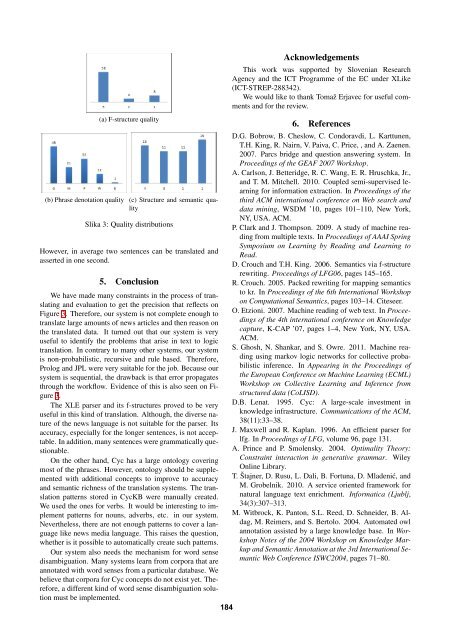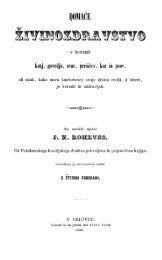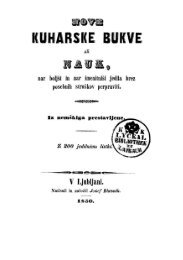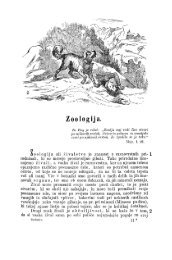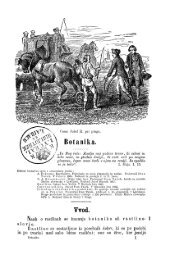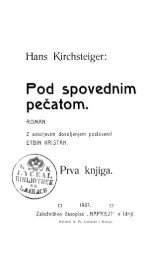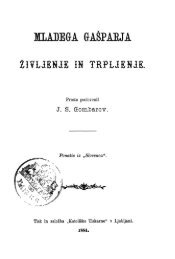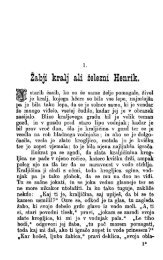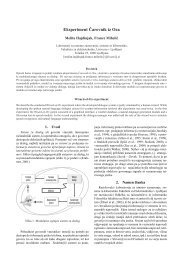Proceedings - Natural Language Server - IJS
Proceedings - Natural Language Server - IJS
Proceedings - Natural Language Server - IJS
You also want an ePaper? Increase the reach of your titles
YUMPU automatically turns print PDFs into web optimized ePapers that Google loves.
(a) F-structure quality<br />
(b) Phrase denotation quality (c) Structure and semantic quality<br />
Slika 3: Quality distributions<br />
However, in average two sentences can be translated and<br />
asserted in one second.<br />
5. Conclusion<br />
We have made many constraints in the process of translating<br />
and evaluation to get the precision that reflects on<br />
Figure 3. Therefore, our system is not complete enough to<br />
translate large amounts of news articles and then reason on<br />
the translated data. It turned out that our system is very<br />
useful to identify the problems that arise in text to logic<br />
translation. In contrary to many other systems, our system<br />
is non-probabilistic, recursive and rule based. Therefore,<br />
Prolog and JPL were very suitable for the job. Because our<br />
system is sequential, the drawback is that error propagates<br />
through the workflow. Evidence of this is also seen on Figure<br />
3.<br />
The XLE parser and its f-structures proved to be very<br />
useful in this kind of translation. Although, the diverse nature<br />
of the news language is not suitable for the parser. Its<br />
accuracy, especially for the longer sentences, is not acceptable.<br />
In addition, many sentences were grammatically questionable.<br />
On the other hand, Cyc has a large ontology covering<br />
most of the phrases. However, ontology should be supplemented<br />
with additional concepts to improve to accuracy<br />
and semantic richness of the translation systems. The translation<br />
patterns stored in CycKB were manually created.<br />
We used the ones for verbs. It would be interesting to implement<br />
patterns for nouns, adverbs, etc. in our system.<br />
Nevertheless, there are not enough patterns to cover a language<br />
like news media language. This raises the question,<br />
whether is it possible to automatically create such patterns.<br />
Our system also needs the mechanism for word sense<br />
disambiguation. Many systems learn from corpora that are<br />
annotated with word senses from a particular database. We<br />
believe that corpora for Cyc concepts do not exist yet. Therefore,<br />
a different kind of word sense disambiguation solution<br />
must be implemented.<br />
184<br />
Acknowledgements<br />
This work was supported by Slovenian Research<br />
Agency and the ICT Programme of the EC under XLike<br />
(ICT-STREP-288342).<br />
We would like to thank Tomaˇz Erjavec for useful comments<br />
and for the review.<br />
6. References<br />
D.G. Bobrow, B. Cheslow, C. Condoravdi, L. Karttunen,<br />
T.H. King, R. Nairn, V. Paiva, C. Price, , and A. Zaenen.<br />
2007. Parcs bridge and question answering system. In<br />
<strong>Proceedings</strong> of the GEAF 2007 Workshop.<br />
A. Carlson, J. Betteridge, R. C. Wang, E. R. Hruschka, Jr.,<br />
and T. M. Mitchell. 2010. Coupled semi-supervised learning<br />
for information extraction. In <strong>Proceedings</strong> of the<br />
third ACM international conference on Web search and<br />
data mining, WSDM ’10, pages 101–110, New York,<br />
NY, USA. ACM.<br />
P. Clark and J. Thompson. 2009. A study of machine reading<br />
from multiple texts. In <strong>Proceedings</strong> of AAAI Spring<br />
Symposium on Learning by Reading and Learning to<br />
Read.<br />
D. Crouch and T.H. King. 2006. Semantics via f-structure<br />
rewriting. <strong>Proceedings</strong> of LFG06, pages 145–165.<br />
R. Crouch. 2005. Packed rewriting for mapping semantics<br />
to kr. In <strong>Proceedings</strong> of the 6th International Workshop<br />
on Computational Semantics, pages 103–14. Citeseer.<br />
O. Etzioni. 2007. Machine reading of web text. In <strong>Proceedings</strong><br />
of the 4th international conference on Knowledge<br />
capture, K-CAP ’07, pages 1–4, New York, NY, USA.<br />
ACM.<br />
S. Ghosh, N. Shankar, and S. Owre. 2011. Machine reading<br />
using markov logic networks for collective probabilistic<br />
inference. In Appearing in the <strong>Proceedings</strong> of<br />
the European Conference on Machine Learning (ECML)<br />
Workshop on Collective Learning and Inference from<br />
structured data (CoLISD).<br />
D.B. Lenat. 1995. Cyc: A large-scale investment in<br />
knowledge infrastructure. Communications of the ACM,<br />
38(11):33–38.<br />
J. Maxwell and R. Kaplan. 1996. An efficient parser for<br />
lfg. In <strong>Proceedings</strong> of LFG, volume 96, page 131.<br />
A. Prince and P. Smolensky. 2004. Optimality Theory:<br />
Constraint interaction in generative grammar. Wiley<br />
Online Library.<br />
T. ˇStajner, D. Rusu, L. Dali, B. Fortuna, D. Mladenić, and<br />
M. Grobelnik. 2010. A service oriented framework for<br />
natural language text enrichment. Informatica (Ljublj,<br />
34(3):307–313.<br />
M. Witbrock, K. Panton, S.L. Reed, D. Schneider, B. Aldag,<br />
M. Reimers, and S. Bertolo. 2004. Automated owl<br />
annotation assisted by a large knowledge base. In Workshop<br />
Notes of the 2004 Workshop on Knowledge Markup<br />
and Semantic Annotation at the 3rd International Semantic<br />
Web Conference ISWC2004, pages 71–80.


